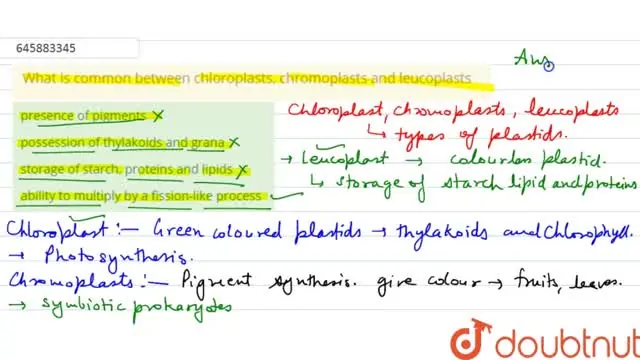What is common between chloroplasts, chromoplasts and leucoplasts
A
presence of pigments
B
possession of thylakoids and grana
C
storage of starch, proteins and lipids
D
ability to multiply by a fission-like process
Video Solution
Text Solution
The correct Answer is:d
Chloroplast, chromoplast and leucoplast are all types of plastids which are classified on the basis of pigments they contain. Plastids are semiautonomous cell orgnelles bounded by two membraneand are found in only plant cell & some unicellular organisms (Euglena) of uncertain affinity. The common among all the three organelles are that they have ability to miltiply by a fission like process because these organelles contain there own genetic material and protein sunthesizing machinery. i.e., DNA , RNA and ribosomes. Plastids are tought to have arisen as a result of an endosymbiotic evetn in which an early photosyunthetic prokaryotic invaded a primitive eukaryotic host. All plastids are derived intially from small undifferentiated plastids termed proproplastiss which are found in the dividing cells in meristems. During cell differentiation oroplastids differentiate into particular types accrodings to the type of cell in which they reside.
chlroplasts are the organelles in which photosythesis taks place. Photosynthesis is an improtant process by which autorophic cells manufacture their own food. Chloroplasts contain the green pigment chlorophyll (this is why plant leaves are geiven) which absorbs light to provided the energy necessary to complete photosynthesis. Chromoplasts are very similar to chlorophyll. Instead, they contain other pigments which give colour to flowers and to leavs colours of light than chlorophyll. Leucoplasts are non-pigmented colourless plastids. Kacking pigments leucplasts are not green, so they are predictably located in roots and non-photosuynthetic tissues of plants. They may become specialized for bulk storage of strach. lipid or protein and are then known as amyloplasts elaioplasts, or protenioplasts. Theses material are realeased from the leucoplasts when the cell requires them.
|
Updated on:21/07/2023
Similar Questions
Chloroplast lacks
View SolutionWhat is common between Earthworm and Cockroach
View SolutionWhat is common between parrot, platypus and kangaroo ?
View SolutionWhat is common between parrot, platypus and kangaroo ?
View SolutionThe colour of chromoplast can be
View SolutionWhat is common between humans and adult Frog
View SolutionWhat is common between earthworm and Periplaneta?
View SolutionWhat is common between NAD and FAD ?
View SolutionWhat is common between earthworm and Periplaneta?
View SolutionWrite the name of different plants parts in which chromoplast, chloroplast and Leucoplast are present.
View Solution


